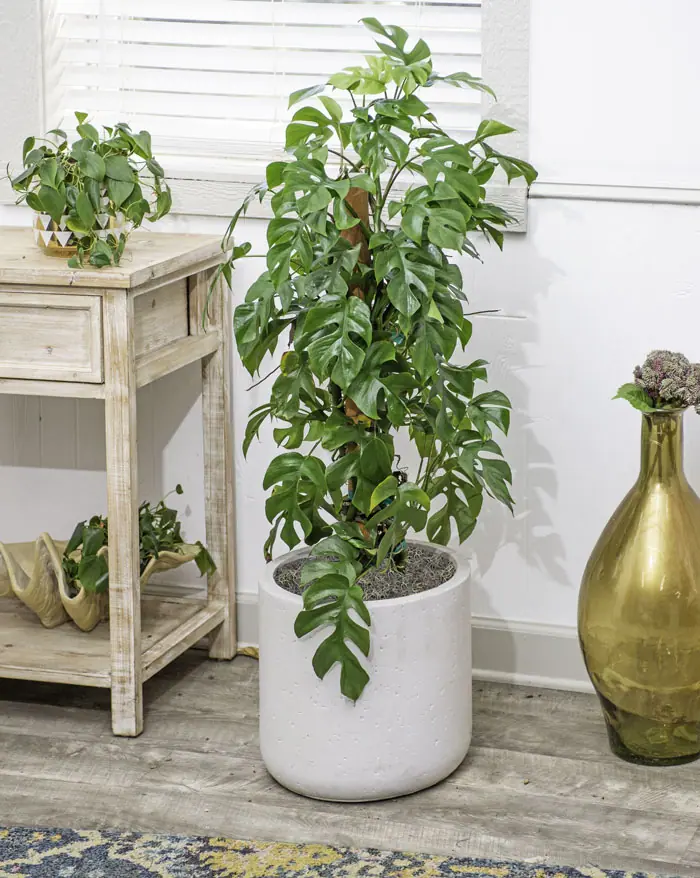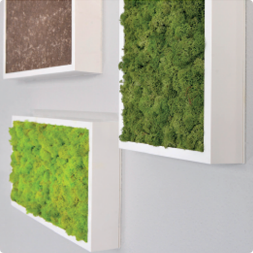Caring for Your Mini Monstera
We are so excited to introduce the newest addition to our plant family: the Mini Monstera! This vining plant is often called many different names- “Monstera Minima”, “Mini Split-Leaf”, “Ginny Philodendron”- but it’s really Raphidophora Tetrasperma, and it’s actually not a Monstera at all! While the two are in the same family, Araceae, and bear a striking resemblance to each other, the R. Tetrasperma is in a totally separate genus originating from Malaysia and Thailand!
This tropical plant’s interesting split leaves, ease of care, and unusual climbing habits contribute to its increasing popularity lately in the Plantz community. Want to add that exotic, jungle-like vibe to your home but don’t have the space for a Monstera deliciosa? The RT stays smaller and grows quicker, making it the must-have tropical houseplant for small spaces. These plants thrive when they have something to climb on, such as the totem that comes with our version, allowing it to grow upwards and really show off its potential.
So without further ado, let’s dive into everything you need to know about caring for your new climbing plant buddy.
Watering Your Mini Monstera
The Rhaphidophora tetrasperma is a moderate drinker and likes to stay pretty moist, but not soggy. The amount of water your RT needs depends entirely on the amount of light it gets, the time of year, and whether it’s in its growing season or not. When the top inch or so of soil feels dry it’s time to give your new buddy a drink. Your Mini Monstera should be happy with getting watered about 4 times a month in the warmer season, and then once every 2 weeks once winter hits.
These plants tend to be very avid drinkers, but they can also be extremely sensitive to overwatering. A good rule of thumb with the Rhaphidophora tetrasperma: if it’s wet, do nothing- if it’s dry, add water. The Mini Monstera Plant isn’t one to pout if it misses a watering every now and then, but its leaves will quickly turn brown or yellow when it’s had too much H2o.
*Helpful hint: use room temperature or lukewarm water when giving your plant friends a drink so you don’t shock their roots with a cold bath!
When you first get your Mini Monstera, it will still be feeding on all of those yummy nutrients that it got while in our care and will likely not need to be fertilized for the first 6 months. After that, we recommend a complete fertilizer formulated for indoor plants, such as our Dyna-Gro plant fertilizer, that’ll keep your R. tetrasperma happy and growing. These babies thrive with regular fertilizing during their growing season, so try feeding them once a month and watch your Mini Monstera grow like crazy!
What Lighting is Best for Your Mini Monstera?
Mini Monsteras are big fans of bright filtered light, so they should be placed near a window that offers plenty of rays. The right amount of sunshine allows its leaves to develop their notable heart shape and deep splits. While this plant can survive in low-light conditions, it won’t do its famous leaf-split or climbing tricks without enough light and will grow slowly with smaller foliage. Too much sun, on the other hand, can cause your leaves to dry out and turn yellow. Our best piece of advice- allow your new friend to get some morning sunlight and then bright shade for the rest of the day!
The Rhaphidophora tetrasperma, like most other aroids and people, doesn’t prefer temperatures that are too hot or too cold. These plants are their best selves in temperatures between 55°F and 85°F. In the summer or winter, avoid air conditioning vents or heaters to reduce any stress on your glossy climber.
In the warmer months, you can transfer your RT outdoors to give your patio or balcony those tropical feels. They can be pretty easy-going when the temperature drops at night, but anything below 55°F and you should bring them indoors. Since this plant is considered a fast grower, always make sure it’s getting the proper light wherever you decided to show it off!

Letting Your Mini Monstera Climb
Have we mentioned the Rhaphidophora tetrasperma likes to climb? Of course, we have- it’s one of the many attributes that makes them so popular among houseplant connoisseurs. Our Mini Monstera comes already “trained” on its totem and will continue to climb as it grows using its aerial roots. When new growth pops out from the base of the plant, you should find literally anything you can to attach it to the totem- nursery tape, zip ties, handcuffs- okay, not handcuffs, but you get the point. Just make sure to make it as least noticeable as possible so you don’t take away from the aesthetic. Always remember- the more sunlight your RT gets, the more it will produce new and climbing growth!
While some may love the look of RT’s overflowing from hanging baskets, leaving them to hang can actually result in patchy growth and smaller leaves without any of the characteristic splits. Keeping them as a floor plant and allowing them to climb up whatever structure you choose will ensure they live a happy and healthy life- and they’ll thank you by adding an exotic ambiance to any space you choose.
We always recommend leaving your new plant additions in the grow pot they arrived in, simply finding a slightly bigger pot that fits your style, and placing the grow pot directing inside. The Mini Monstera is a vigorous grower though, and the day may come where it outgrows its original grow pot and can no longer expand its roots. If up-potting seems to be needed, begin by finding a bigger grow pot and some indoor planting soil. Cover the bottom few inches of the new grow pot with soil and carefully remove your Mini Monstera from its current grow pot. Then, place the root ball on top of the new soil and lightly add more soil until the root ball is totally covered. Give it a misty shower and voila! Your mini climber is ready to take on new adventures.
These plants are mildly toxic to animals, so be sure wherever you decide to let them climb is out of reach for your fur friend’s paws. Mini Monstera plants are really quite easy to grow- all they ask for is the right amount of light, a thoughtful feeding and watering routine, and lots of love to grow tall and gorgeous!


















